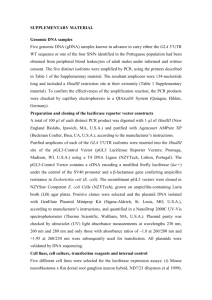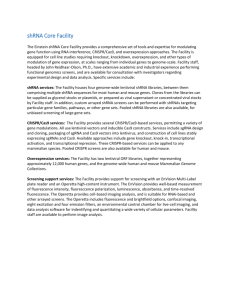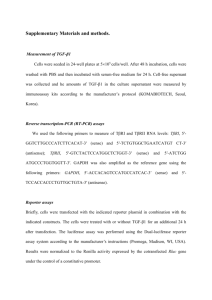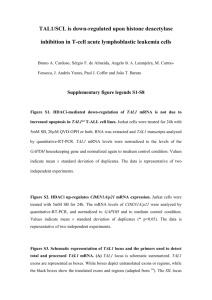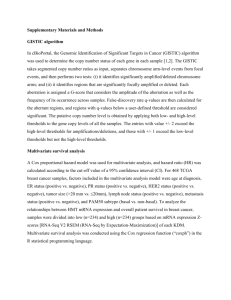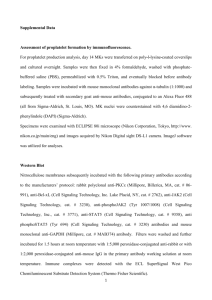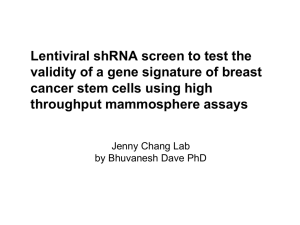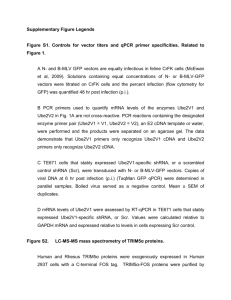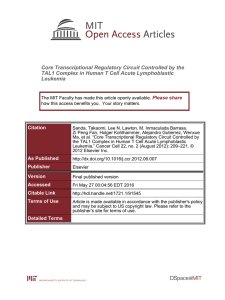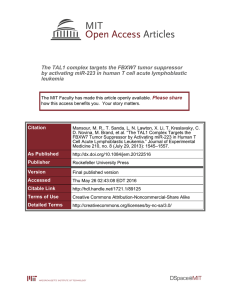Supplementary Information (docx 71K)
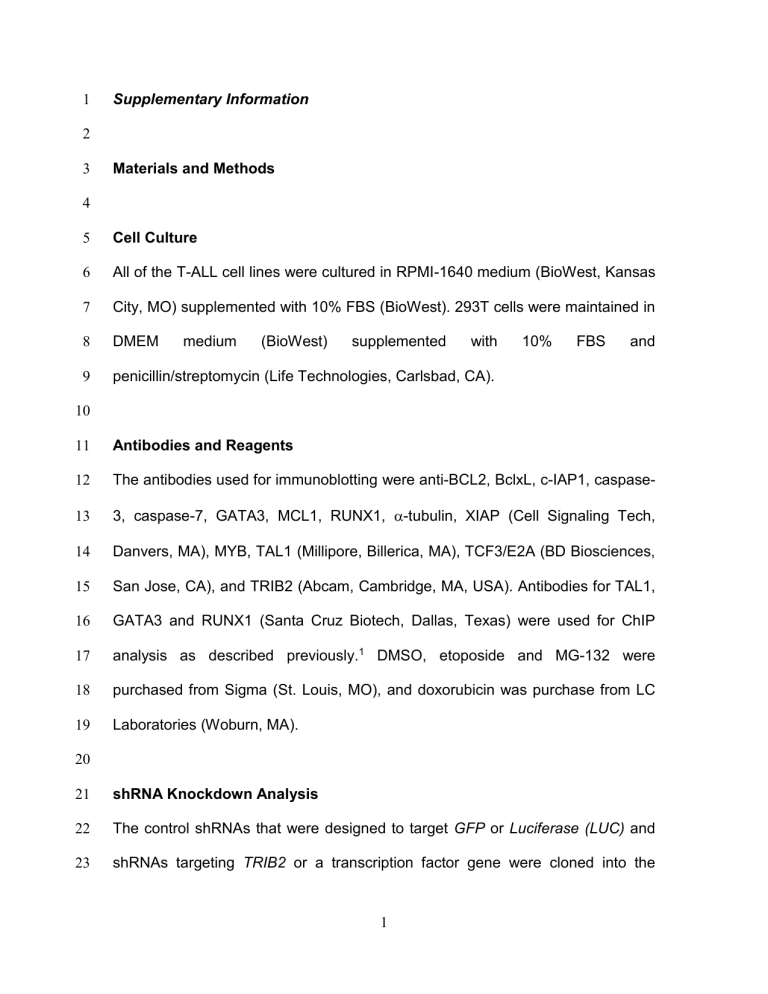
1
2
3
Supplementary Information
Materials and Methods
4
5 Cell Culture
6
7
All of the T-ALL cell lines were cultured in RPMI-1640 medium (BioWest, Kansas
City, MO) supplemented with 10% FBS (BioWest). 293T cells were maintained in
8
9
10
DMEM medium (BioWest) supplemented with 10% FBS and penicillin/streptomycin (Life Technologies, Carlsbad, CA).
11
12
Antibodies and Reagents
13
The antibodies used for immunoblotting were anti-BCL2, BclxL, c-IAP1, caspase-
3, caspase-7, GATA3, MCL1, RUNX1,
-tubulin, XIAP (Cell Signaling Tech,
14
15
Danvers, MA), MYB, TAL1 (Millipore, Billerica, MA), TCF3/E2A (BD Biosciences,
San Jose, CA), and TRIB2 (Abcam, Cambridge, MA, USA). Antibodies for TAL1,
16
17
18
GATA3 and RUNX1 (Santa Cruz Biotech, Dallas, Texas) were used for ChIP analysis as described previously.
1 DMSO, etoposide and MG-132 were purchased from Sigma (St. Louis, MO), and doxorubicin was purchase from LC
19
20
Laboratories (Woburn, MA).
21
22
23 shRNA Knockdown Analysis
The control shRNAs that were designed to target GFP or Luciferase (LUC) and shRNAs targeting TRIB2 or a transcription factor gene were cloned into the
1
24
25
26
27
28
29 lentiviral vector pLKO.1-puro and used as reported previously.
1 Briefly, individual shRNA constructs were co-transfected into 293T cells with the packaging plasmids pMDLg/pRRE and pRSV-Rev together with the envelope plasmid pMD2.G using the FuGENE 6 transfection reagent (Roche, Indianapolis, IN) according to the manufacturer’s instructions. Supernatants containing the lentivirus were then collected and filtered through a 0.45
m filter (Thermo,
30
31
Waltham, MA). shRNA knockdown experiments were then subsequently
32 conducted by first infecting T-ALL cells with lentivirus in the presence of
Polybrene (8
g/ml: Millipore) by centrifugation at 1,300 rcf for 1.5 hrs. Cells
33 were selected by the addition of puromycin (0.7
g/ml: Sigma) for at least 36 hrs
34
35 after infection. Finally, the cells were collected from 72 hrs post infection onwards for various downstream experiments. shRNA sequences are described below:
36
Target
Genes shRNA IDs shGFP shRNA sequences
ACAACAGCCACAACGTCTATA GFP
LUC shLUC CTTCGAAATGTCCGTTCGGTT
TRIB2
TRIB2
TAL1
GATA3 shTRIB2 #1 (main
CGCCCGAGACTCCGAACTTGT figure) shTRIB2 #4
GCGTTTCTTGTATCGGGAAAT
(Supplementary Figure) shTAL1 shGATA3
GCTCAGCAAGAATGAGATCCT
CATCCAGACCAGAAACCGAAA
2
RUNX1 shRUNX1 CGGCAGAAACTAGATGATCAG
TCF3/E2A shE2A
TCF/12HEB shHEB
GCAGCCTCTCTTCATCCACAT
GCAATCATTCAGTCCTGTCTA
LMO1
37
38 Rescue Study shLMO1 GCCACATTAGAACTTCTCCGT
41
42
43
39
40
For the rescue study involving the overexpression of the XIAP or BCL2 protein, the wild-type XIAP or BCL2 cDNA was first cloned into the pMSCV-IRES-GFP
(“MIG”) retrovirus expression vector. A retrovirus expressing an empty vector
(EV) or XIAP or BCL2 cDNA was propagated in 293T cells by co-transfection of packaging plasmid pMD-MLV and envelope plasmid VSV-G using FuGENE 6
44
45
(Roche). Jurkat cells were first infected with either retrovirus expressing an MIG
(EV) or XIAP or BCL2 cDNA in the presence of Polybrene (8
g/ml: Millipore) by
46 centrifugation at 1,300 rcf for 1.5 h. After 24 hrs of retrovirus infection, the cells
47
48 were infected with lentivirus expressing LUC or TRIB2 shRNA, as detailed above.
52
53
54
49
50
51
Cell Viability Assay
The cell viability of cells was measured using the CellTiter-Glo kit (Promega,
Madison, WI). Briefly, T-ALL cells were seeded in 96-well plates after lentivirus infection. The cell viability was then measured according to the manufacturer’s instructions using the Tecan Infinite
®
200 PRO plate reader (Tecan, Seestrasse,
Switzerland). For treatment with chemical inhibitors, the cells were first plated
3
55
56
57 into 96-well plates and incubated for the indicated time points in either DMSO
(control), etoposide or doxorubicin before the cell viability was measured.
58
59
Apoptosis Analysis
The cells were washed in PBS, incubated in staining buffer containing PE-labeled
60
61
62 anti-AnnexinV antibody (MBL International, Woburn, MA) and analyzed by BD
LSR II (BD Biosciences).
63
64
Protein Extraction and Immunoblotting
For protein extraction, T-ALL cell pellets were lysed in RIPA buffer [50 mM Tris
65
66
67
(pH 8.0), 10 mM EDTA, 150 mM NaCl, 0.5% deoxycholic acid, 0.1% SDS, 1%
NP-40, 1 mM PMSF, 1 mM sodium pyrophosphate, 1 mM sodium orthovanadate and protease inhibitor cocktail (Roche)]. For immunoblotting, the protein
68
69 concentration was first measured using the DC protein assay kit (Bio-Rad
70
Laboratories, Hercules, CA). Equal amounts of protein for each sample were diluted in Laemmli sample buffer (Bio-Rad Laboratories) including
-
71
72 mercaptoethanol (Bio-Rad) and resolved on an SDS-PAGE gel. The proteins were then transferred onto a polyvinylidene difluoride (PVDF) membrane (Bio-
73
74
75
Rad Laboratories). The membrane was then blocked with 5% non-fat milk, probed with the designated primary and secondary antibodies and subsequently developed using the enhanced chemiluminescence method.
76
77 RNA Extraction and Gene Expression Analysis
4
78
79
80
The total RNA from cells was extracted using the RNeasy Mini Kit (QIAGEN,
Valencia, CA). In total, 1 µg of the purified total RNA was then reversetranscribed using QuantiTect (QIAGEN) according to the manufacturer’s
81
82 instructions. The mRNA expression levels of the genes of interest were then determined by conducting quantitative real-time qPCR carried out on the ABI
83
84
85
7000 Detection System (Applied Biosystems, Foster City, CA) using the Power
SYBR Green PCR Master Mix (Roche) accordin g to the manufacturer’s
86 instructions. The primer sequences of the genes of interest are described below:
Target Genes Direction PCR primer sequences (5’ to 3’)
TRIB2-CDS Forward GGAAGACGCCTACATTCTGC
Reverse GTAGCTGCCACTGGTGTTCA
TRIB2-3 ’UTR Forward TGGTCCTGTTTTTGGGTAGG
TAL1
TCF3/E2A
GATA3
RUNX1
ALDH1A2
Reverse
Forward
Reverse
Forward
Reverse
Forward
Reverse
Forward
Reverse
Forward
GTCTGCACATACATGCCACA
TTCCCTATGTTCACCACCAA
AAGATACGCCGCACAACTTT
TCATCCTGAACTTGGAGCAG
CAACCACACCTGACACCTTT
TTCAGTTGGCCTAAGGTGGT
CGCCGGACTCTTAGAAGCTA
CTGGTGTCTTCAGCCAGATG
CGACTGTGTACCGTGGACTG
AGGCCCTCACAGTGTCTTCT
5
GAPDH
JAK1
LIG4
XIAP
Reverse
Forward
Reverse
Forward
Reverse
Forward
Reverse
Forward
ACATCTTGAATCCCCCAAAG
CTCCTCTGACTTCAACAGCGACAC
TGCTGTAGCCAAATTCGTTGTCAT
CCCAAATTCAGGATTGGTTC
AGAGTGGCCACAGGTTTGAC
GTACGGAATTTGATCCATGC
CATTTGTTCCACGGTTTGAA
AACCAAAACCCCAGGGATAG
TCF12/HEB
MYB
Reverse
Forward
Reverse
Forward
TCGGAAACTGCTGGGATTAC
TCTCCAGTTTCCATTGTTGG
TTCTTGCTGCTGGTTGAAAA
TGTTGCATGGATCCTGTGTT
Reverse AGTTCAGTGCTGGCCATCTT
87
88
89
90
Construction of the ALDH1A2 Enhancer Reporter Plasmid and the
Generation of a Stably Expressing Cell Line
To clone the ALDH1A2 enhancer reporter plasmid, a genomic region (887 bp in
91
92 size: Chr 15, 56,093,389-56,094,275, hg18) was identified via enriched binding by the various transcription factors involved in the TAL complex, as observed in
93
94 the ChIP-seq data from Jurkat cells.
1 This region was amplified by PCR from genomic DNA extracted from Jurkat cells using the QIAamp DNA Blood Mini Kit
95
96
(QIAGEN) and cloned into the pGL4.27 [luc2P/minP/Hygro] vector (Promega) upstream of a minimal promoter and the luciferase gene. The following primers
6
97
98
99 were used for the PCR amplification:
ALDH1A2 enh Fw: 5’-CAC CAC TAG TTA
GTT TGG TTA GAG T3’ and ALDH1A2 enh Rv: 5’-TAT CCA ACA GAC GTC
CCC TTT3’. For the generation of cell lines stably expressing the ALDH1A2
100
101 enhancer reporter plasmid, Jurkat cells were transfected with the ALDH1A2 enhancer reporter plasmid using the NEON
®
Transfection System (Life
102
103
Technologies) and single clones expressing the reporter plasmid were selected using 400
g/ml hygromycin (Sigma-Aldrich). As a negative control, Jurkat cells
104
105 were transfected with the empty pGL4.27 vector and stable cell lines were also selected with hygromycin as described.
106
107 One-Glo TM + Tox Luciferase Reporter and Cell Viability Assay
108
109
The Jurkat cells stably expressing either the empty pGL4.27 or the ALDH1A2 enhancer reporter plasmid were first infected with lentivirus expressing the
110
111
112 desired shRNAs as described above. After 72 hrs of infection, the luciferase activity was measured using the One-Glo TM + Tox Luciferase Reporter and Cell viability assay kit (Promega ) following the manufacturer’s instructions. Briefly, the
113
114 cell viability was first determined using the CellTiter-Fluor TM Assay, and the fluorescence was measured using the Tecan Infinite
®
200 PRO plate reader
115
116
117
(Tecan). The firefly luciferase activity was then determined using the One-Glo TM
Luciferase Assay with the same samples, and the fluorescence (cell viability) was also measured using the Tecan Infinite ® 200 PRO plate reader (Tecan). The
118
119 relative luciferase gene expression of each sample was then calculated by normalizing the luminescence readings to the fluorescence readings.
7
120
121
122
Chromatinimmunoprecipitation (ChIP)
Jurkat cells transduced with control or TRIB2 shRNA were cross-linked in fresh
123
124
11% formaldehyde solution for 10 minutes at room temperature followed by
125
126
127 quenching with glycine. Cells were rinsed twice with 1xPBS, pelleted by centrifugation and flash frozen in liquid nitrogen and stored at
–80°C. Cell pellets were lysed as previously described 1 and sonicated by Bioruptor’s sonicator at a
128
129 high power for 50 x 30 second pulses (30 second pause between pulses).
Samples were ke pt at 4°C at all times. ChIP reaction was performed, as previously described.
1 Quantitative PCR was carried out on the ABI 7000
130
131
132
Detection System (Applied Biosystems) using the Power SYBR Green PCR
Master Mix (Roche) and the following primers: ALDH1A2 CHIPPCR Fw: 5’- GTT
CCA CCA AGT CTG CAA GC-
3’ and ALDH1A2 CHIP-PCR Rv: 5’- GCC TGG
133
134
135
138
139
CTT TCT CTC TTG GT-3 for ALDH1A2 gene region bound by TAL1 complex.
LIG4 CHIPPCR Fw: 5’- TGA CAG ACC ACT TTC CTG AAA CT-3’ and LIG4
CHIP-
PCR Rv: 5’- GAG CAA ATT TTG GGA GAT AGG GC -3’ for
LIG4 gene
136
137 region bound by TAL1 complex.
Microarray Gene Expression Analysis and Gene Set Enrichment Analysis
(GSEA)
140
141
To analyze global gene expression changes after TRIB2 knockdown, Jurkat cells were transduced with control shRNA or shRNA targeting TRIB2 in biological
142 duplicate. Total RNA was harvested using TRIzol reagent followed by a column
8
143
144
145 purification using the RNeasy Mini kit (Qiagen). A total of 4 RNA samples (2 controls and 2 TRIB2 knockdowns) were used for microarray expression analysis.
Genome-wide RNA expression analysis was performed using the HG U133 plus
146
147
2.0 microarray chip (Affymetrix, Santa Clara, CA) at the Dana-Farber Cancer
Institute, Boston. The expression data can be found at
148
149
150 http://www.ncbi.nlm.nih.gov/geo/ under accession number GSE66013. After normalization using the dChip software (Dana-Farber Cancer Institute), 2 30,904 of 54,613 probes with presence-call >50% (2/4 arrays) were filtered. The genes
151
152 differentially expressed between the 2 controls and 2 knockdown samples were selected at a lower 90% confidence bound of fold-change >2.0, P-value <0.05 by
153
154
155 two sample t-test (two-tailed) and mean difference >50. GSEA (Broad Institute,
Cambridge, MA) 3 was performed for the filtered genes using the “Ratio of
Classes
” for metrics for ranking genes. The high-confidence target genes that are
156
157 downregulated by knockdown of TAL1 , GATA3 or RUNX1 were identified previously 1 and used as gene sets for GSEA. Heatmaps were created using the
158
159
160
Gene Pattern software (Broad Institute) (Figure 1) or GSEA (Supplementary
Figure 2a). For the analysis of primary T-ALL patient samples, a dataset reported by Winter et al 4 (GEO accession number GSE14618) was used and normalized
161
162 by the dChip software. mRNA expressions of XIAP (228363_at) and TRIB2
(202478_at) on the Affymetrix U133 Plus 2.0 chip were analyzed.
163
164 Published ChIP-seq Datasets Used in This Study
9
165
166
167
A previously published ChIP-seq dataset was used and mapped to HG18, as previously reported by us.
1
168
169
170
Statistical Analysis
Significant values ( p -values) were calculated using the twotailed Student’s t-test.
All pvalues that were less than or equal to 0.05 were considered statistically
171
172 significant. Correlation of expression values between two genes was analyzed by Pearson’s r using Prism software (Graphpad software, La Jolla, CA).
173
10
174
175
176
Supplementary Table 1. Genes significantly regulated after TRIB2 knockdown in Jurkat cells.
177
178
Supplementary Table 2. Expression of apoptosis-related genes after TRIB2 knockdown in Jurkat cells.
179
180
181
11
182
183
184
Supplementary Figure Legends
Supplementary Figure 1. (a) T-ALL cell lines were lysed and whole-cell extracts
185
186 were subjected to Western blot analysis with antibodies specific for TAL1, TRIB2 or α-tubulin (loading control).
(b) Global gene expression in Jurkat cells transduced with TRIB2 shRNA (shTRIB2) or control GFP shRNA (shGFP) were
187
188
189 measured by microarray analysis. The experiment was performed with biological duplicates. The gene probes significantly down- or upregulated by TRIB2 knockdown (KD) compared to control were shown. (c) TRIB2 shRNA (shTRIB2)
190
191 and control GFP shRNA (shGFP) were transduced by lentivirus infection into
Jurkat cells in biological duplicates ( “dup1” and “dup2”). TRIB2 mRNA
192
193
194 expression was measured by quantitative RT-PCR using two different primer sets targeting the coding DNA sequence (CDS) or 3 ’ UTR and normalized by GAPDH expression. Gene expression compared to
“shGFP-dup1” was shown as the mean ± standard deviation (SD) of duplicate experiments. (d) mRNA 195
196
197
200
201 expressions of TRIB2 and XIAP were analyzed by microarray analysis using a dataset reported by Winter el al 4 . P<0.05 by the
Pearson’s r.
(e) The TRIB2
198
199 shRNA (#1 or #4) and control GFP shRNA were transduced by lentivirus infection into Jurkat cells. Whole cell extracts were subjected to immunoblot analysis with antibodies indicated. Cleaved forms of the arrowheads. (f) caspase-3 and PARP were shown by
T-ALL cell lines (Jurkat, RPMI-8402, CCRF-CEM, MOLT-4,
202
203
204
KOPT-K1 and DND-41) were transduced by lentivirus infection with the shTRIB2 or shGFP. The cell viability was measured at days 3 and 7 after lentivirus infection. The growth rate (day 7/day 3) relative to control is shown as the mean
12
205
206
207
± SD of triplicate experiments. ***p < 0.001 by two-sample, two-tailed t-test.
(g,h)
Jurkat cells were first transduced by retrovirus infection with cDNA encoding the
XIAP or BCL2 gene or an empty vector. The cells were then transduced by
208
209 lentivirus infection with TRIB2 shRNA (shTRIB2) or Luciferase shRNA (shLUC: control). (g) Apoptosis was analyzed at day 3 after lentiviral infection by flow
210
211
212 cytometric analysis of cells stained with AnnexinV-PE.
(h) The cell viability was measured at day 3 and 7 after lentivirus infection. The growth rate (day 7/3) relative to control is shown as the mean ± standard deviation (SD) of triplicate
213
214 experiments; ***p<0.001 by two sample, two-tailed t-test. (i) Jurkat cells were transduced by retrovirus infection with cDNA encoding the TRIB2 gene or an empty vector (EV). The cells were then treated with etoposide (10
µM) or 215
216
217 doxorubicin (100 nM) for 24, 48 or 72 hours. The cell viability was measured,
218
219 and the growth inhibition (%) compared to the DMSO-treated control was shown
± SD of triplicate experiments; *p<0.05, ***p<0.001 by two sample, two-tailed ttest.
220
221
222
Supplementary Figure 2.
(a) The high-confident TAL1 target genes that were downregulated by TAL1 knockdown (KD) were determined previously 1 . The
223
224 expression profile of these genes after TRIB2 knockdown (KD) in Jurkat cells were analyzed by GSEA (Figure 2a, left). A heatmap generated is shown. (b, c)
225
226
227
Jurkat cells were transduced with the shTRIB2 or shGFP by lentivirus infection
(b) or with the cDNA encoding TRIB2 (MIG-TRIB2) or an empty vector ( MIGEV)
(c). The mRNA expression of the TAL1 complex members (TAL1, RUNX1,
13
228
229
230
GATA3, MYB and E2A), the TAL1 targets (ALDH1A2 and LIG4) and a non-TAL1 target (JAK1) were measured by quantitative RT-PCR and normalized by
231
232
GAPDH expression. Gene expression compared to shGFP or EV-transduced cells was shown as the mean ± standard deviation (SD) of duplicate experiments;
*p<0.05, **p<0.01, by two sample, two-tailed t-test. (d) Jurkat cells were
233
234
235 transduced by retrovirus infection with a MIG-EV or MIG-TRIB2. Whole cell extracts were subjected to immunoblot analysis with antibodies indicated. (e,f)
Jurkat cells were first transduced by retrovirus infection with a MIG-EV or cDNA
236
237 encoding XIAP (MIG-XIAP: e) or BCL2 (MIG-BCL2: f). The cells were then transduced by lentivirus infection with the TRIB2 shRNA or Luciferase shRNA
238
239
(shLuc: control). Whole cell extracts were subjected to immunoblot analysis with
240 antibodies specific for TRIB2, Caspase 3, PARP, XIAP, TAL1, GATA3, RUNX1,
MYB, E2A, BCL2, and
-tubulin. (g) Jurkat cells transduced with a MIG-EV or
241 MIG-TRIB2 were treated with MG-132 (30
M) for 4 hrs. Whole cell extracts were
242
243
244 subjected to immunoblot analysis with antibodies indicated ( expression of E2A left ). The mRNA
was measured by quantitative RT-PCR and normalized by
245
246
GAPDH expression ( right ). Gene expression compared to DMSO-treated control was shown as the mean ± SD of duplicate experiments.
(h) ChIP-seq gene tracks represent transcription factors bound at the ALDH1A2 gene in Jurkat cells.
247
248
249
Bound transcription factors [TAL1, HEB, E2A, LMO1, GATA3, RUNX1, CBP, and
RNA polymerase 2 (RNAP2)] in Jurkat cells are shown. The x -axis indicates the linear sequence of genomic DNA, and the y -axis indicates the total number of
250 mapped reads. The black horizontal bar indicates the genomic scale in kilobases
14
251
252
253
(kb). The blue boxes in the gene map represent exons, and the arrows indicate the location and direction of the transcriptional start site. The ALDH1A2 enhancer is indicated by an arrowhead. (i) A schematic representation of the experimental
254
255
256 design. The ALDH1A2 enhancer was introduced into the reporter construct carrying a minimum promoter sequence (promoter) and a luciferase gene. The luciferase reporter construct was transfected into Jurkat cells. The luciferase
257
258 activity was measured after knockdown of a transcription factor (TF). (j) ChIP analysis was performed with specific antibodies for TAL1, GATA3, RUNX1 or
259
260 control IgG in Jurkat cells transduced with control
(shTRIB2)
(shGFP) or TRIB2 shRNA
. The amount of genomic DNA in ChIP and input (whole cell lysate)
261
262
263 samples were measured by quantitative PCR analysis using specific primers targeting the regions within ALDH1A2 and LIG4 genes bound by the TAL1
264
265 complex. Each ChIP fraction was normalized to input and shown as fold-change compared to IgG: mean ± SD of duplicate experiments.
(k) TRIB2 contributes to
T-cell leukemogenesis by positively regulating the oncogenic TAL1 complex and
266
267
XIAP and by negatively regulating the tumor suppressor E2A .
268 References
269
270
271
272
273
274
275
276
277
278
1. Sanda T, Lawton LN, Barrasa MI, Fan ZP, Kohlhammer H, Gutierrez A , et al.
Core transcriptional regulatory circuit controlled by the TAL1 complex in human T cell acute lymphoblastic leukemia. Cancer cell 2012 Aug 14;
22 (2) : 209-221.
2. Li C, Wong WH. Model-based analysis of oligonucleotide arrays: expression index computation and outlier detection. Proceedings of the
National Academy of Sciences of the United States of America 2001 Jan
2; 98 (1) : 31-36.
3. Subramanian A, Tamayo P, Mootha VK, Mukherjee S, Ebert BL, Gillette
MA , et al.
Gene set enrichment analysis: a knowledge-based approach for
15
279
280
281
282
283
284
285
286
287
288 interpreting genome-wide expression profiles. Proceedings of the National
Academy of Sciences of the United States of America 2005 Oct 25;
102 (43) : 15545-15550.
4. Winter SS, Jiang Z, Khawaja HM, Griffin T, Devidas M, Asselin BL , et al.
Identification of genomic classifiers that distinguish induction failure in Tlineage acute lymphoblastic leukemia: a report from the Children's
Oncology Group. Blood 2007 Sep 1; 110 (5) : 1429-1438.
16

